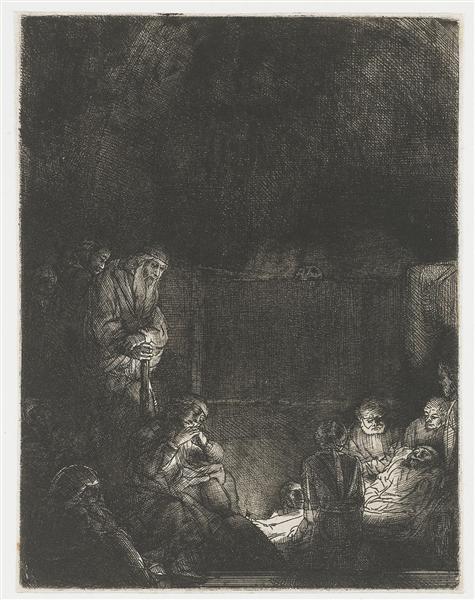Descrição
A pintura "O enterro" de Rembrandt, criado em 1654, é um testemunho monumental da capacidade narrativa e técnica do professor holandês, cujas obras continuam a fascinar e desafiar gerações de amantes da arte. Neste trabalho, Rembrandt entra na história bíblica do enterro de Cristo, um episódio cheio de emoção e simbolismo que move o espectador a confrontá -lo com a questão da morte e da redenção.
A composição do "funeral" é notável por sua atenção aos detalhes e seu domínio em lidar com luz e sombra, técnicas que eram distintas do estilo Rembrandt. Na pintura, o corpo de Cristo, envolto em um lençol branco, é mostrado com uma luminosidade excepcional que contrasta com o fundo escuro. Essa iluminação destaca a tristeza e a solenidade do momento, enquanto as sombras profundas que cercam as figuras fornecem uma sensação de drama e profundidade emocional. A direção clara da luz em direção ao corpo de Cristo enfatiza seu significado na cena, criando um foco de atenção que guia o olhar do espectador.
Entre os personagens que compõem a cena, várias figuras que expressam uma gama notável de emoções podem ser identificadas. A expressão de dor e angústia nos rostos dos enlutados captura a desesperança que é vivida neste momento crucial. O uso de gestos e posições em cada uma das figuras contribui para a criação de uma narrativa visual que convida o espectador a compartilhar a penalidade que apreende os caracteres. Rembrandt consegue humanizar esses personagens, permitindo que o espectador sinta uma conexão emocional com eles.
Um dos aspectos mais interessantes do "Funeral" é a qualidade da pincelada e a textura que define o trabalho. Rembrandt usa uma técnica de imposto que contribui para cada elemento uma corporalidade tangível. Os personagens dos personagens, com sua rica diversidade tonal que vai de Ocher e terras a tons de vermelho e azul intenso, parecem ganhar vida. Esta diversidade cromática não apenas adorna a pintura, Também estabelece um diálogo entre as figuras, sugerindo a unidade do grupo no meio de duelo e tristeza.
O uso da cor no trabalho é essencial para transmitir a atmosfera emocional da cena. Tons quentes predominam, evocando o calor do amor e da tristeza que acompanha a perda. No entanto, o alvo puro da mortalha de Cristo também pode ser interpretado como um símbolo de pureza e esperança, uma visão que convida a redenção além da morte, reforçando assim a dualidade de sofrimento e conforto.
Ao contextualizar "o enterro" na produção geral de Rembrandt, é evidente que este trabalho está alinhado com outras expressões de sua obra -prima relacionada a questões de amor, sacrifício e redenção. Embora existam semelhanças com outras interpretações do sacrifício de Cristo em arte barroca, Rembrandt se destaca por sua capacidade de introspecção e humanismo, na qual cada figura parece carregar com sua própria história de amor e perda.
"O enterro" não apenas representa um episódio religioso, mas também transcende seu contexto histórico e iconografia tradicional, explorando a profundidade da dor humana. Numa época em que a arte barroca estava inclinada para a grandiosidade e o drama, Rembrandt ousa retratar o interno e o íntimo; Uma decisão que ressoa fortemente em sua produção. Este trabalho convida o espectador a se juntar a uma experiência emocional que vai além da superfície visual, transformando o ato de investigar um ato de sentir. Em conclusão, "The Burial" é uma obra que encapsula não apenas o domínio técnico de Rembrandt, mas sua profunda compreensão da condição humana, o que o torna um trabalho essencial dentro do cânone da arte ocidental.
KUADROS ©, um pintura famoso em sua parede.
Reproduções de pinturas petróleo feito à mão, com a qualidade dos artistas profissionais e o selo distinto de KUADROS ©.
Serviço de reprodução de imagens com garantia de satisfação. Se você não está completamente satisfeito com a réplica de seu pintura, Reembolsamos seu dinheiro 100%.

